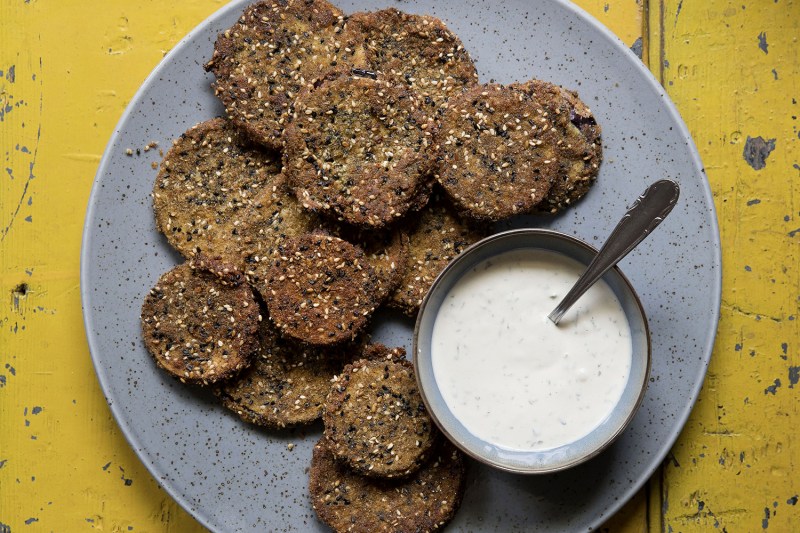When trying to decide what kind of meal to make when you are having both meat eaters and non-meat eaters over for dinner, it’s always smart to look at cultures with rich histories that utilize a wide variety of ingredients that did not, previously, say “moo,” “oink,” et cetera. One such food culture is Israeli cuisine. One food that pops up often in Israeli cuisine – and in other Middle Eastern cuisines – that works as a great substitute for meat is eggplant.
Whether you know the vegetable as eggplant or aubergine, it’s a delicious option when you’re looking to appease people with different palates, especially when it is sliced, breaded and fried. To show just how easy it is to do that, we looked to Jigal Krant’s new book TLV (Smith Street Books, 2019) and his recipe for eggplant schnitzels. These little delights take basically no time to prepare and are delicious on their own or as part of a larger meal.

You can order TLV here.
Eggplant Schnitzel Recipe

(Makes 15)
The simplest way to prepare eggplant slices as if they were meat is to bread them and pan-fry them. According to Claudia Roden, the unsurpassed chronicler of Jewish cuisine, eggplant schnitzels have long been an important part of the Shabbat lunch in many Jewish communities. My mother serves them as a side dish on Friday evenings, before they’ve completely lost their crispness (after all, cooking is prohibited on Shabbat). They’re at their best eaten lukewarm, just a few minutes after cooking.
Ingredients:
- 2 tbsp plain (all-purpose) flour
- 2 eggs
- 35 g (1.25 oz) dry breadcrumbs or 20 g (.75 oz) panko
- 2 tbsp za’atar
- 1 tbsp TLV spice mix or ras el hanout/Baharat
- 1 tbsp sesame seeds
- 1 tbsp nigella seeds
- 1 long, thin eggplant
- Coarse sea salt
- Sunflower or peanut oil for frying
- 3 tbsp plain yogurt
- 3 tbsp raw tahini
- 2 mint sprigs, chopped
- 1 tsp lemon juice
Method:
- Sprinkle the flour onto a large plate. Beat the eggs in a bowl. Mix the breadcrumbs, za’atar, spice mix, sesame seeds and nigella seeds and sprinkle onto a separate plate.
- Slice the eggplant into thick rounds and season with salt. Dredge each eggplant slice first in the flour, then dip it in the beaten egg, then coat in the breadcrumb mixture.
- Heat the oil in a large, heavy-based frying pan over medium-high heat – use enough oil to reach halfway up the eggplant slices. Fry the breaded eggplant slices for 3-4 minutes on each side, until the coating is golden brown and the eggplants are tender. Remove from the oil and drain on a plate lined with a paper towel.
- Just before serving, mix the yoghurt, tahini, mint, and lemon juice, loosening it with a little water or milk if necessary. Serve the sauce alongside the eggplant schnitzels.
Recipe and photo courtesy of TLV by Jigal Krant. Smith Street Books 2019. Photo by Vincent van den Hoogen.
Editors' Recommendations
- How to make wild goose pastrami according to the ‘MeatEater’
- A Fun and New Outdoor Cookbook From Men With The Pot
- These Are the Best Meat Alternatives, According to a Carnivore
- 5 Best Cookbooks About Meat That Every Carnivore Should Read
- Easy, Elegant, Elevated: Level Up Your Dinner Menu With Beans




